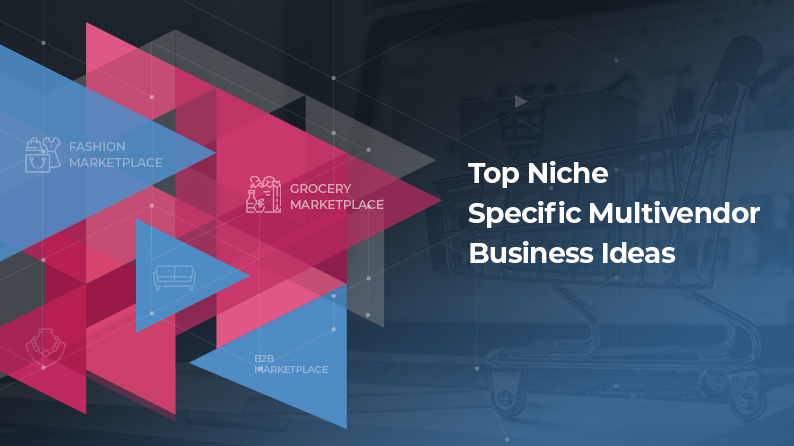Published Date 21 Nov 2025
The digital revolution has completely reshaped how businesses operate, especially when it comes to sourcing essential resources. Companies are no longer bound by local distributors or fragmented catalogs. Furthermore, the rise of the Business-to-Business (B2B) marketplace has introduced an era of efficiency, transparency, and choice, particularly in the multi-billion-dollar sector of office supplies and services.
This blog will provide you with a comprehensive, expert-level guide to understanding, planning, developing, and launching a successful B2B marketplace specifically tailored for the office environment. Further, you will explore how B2B differs from B2C, essential features, revenue strategies, and compare the most viable development paths.
Table of Contents
- What is a B2B Marketplace for Office Supplies & Services?
- Top B2B Marketplaces for Office Supplies
- Types of B2B Marketplaces for Office Supplies and Services
- How to Build Your B2B Marketplace for Office Supplies & Services
- Yo!Kart: A Readymade Software to Build a B2B Marketplace for Office Supplies in a Week
- Conclusion
- FAQs
What is a B2B Marketplace for Office Supplies & Services?
A B2B marketplace is an online platform where multiple businesses (suppliers/sellers) transact with other businesses (buyers/procurement teams) on a single, aggregated digital channel.
Specifically, a B2B Marketplace for office supplies and services acts as a central digital hub connecting manufacturers, wholesalers, and specialized service providers, such as IT support, cleaning services, and office coffee/snack delivery, directly with corporate buyers, small and medium enterprises (SMEs), and educational institutions.
Key Differentiators of B2B and B2C Marketplaces
B2B and B2C marketplaces operate on different business models and have unique features tailored to their target audiences. Understanding these key differentiators helps entrepreneurs and businesses build platforms that effectively cater to the specific needs of corporate buyers or individual consumers.
| Aspect | B2B Marketplace | B2C Marketplace |
| Transaction Size | Large-volume orders, bulk pricing | Small-volume, individual purchases |
| Pricing Structure | Custom quotes, tiered pricing, negotiated contracts | Fixed retail prices |
| Buyer Structure | Multiple users, approval workflows, and company roles | A single user makes purchase decisions |
| Payment Methods | Purchase Orders (PO), credit accounts, and custom terms | Instant payment (credit card, digital wallets) |
| Product Range | Specialized products and services (e.g., MRO, office furniture, IT services) | Standard consumer products (e.g., clothing, electronics) |
| Order Process | Multi-step process with approvals and negotiations | Quick, direct purchasing |
| Customer Support | Dedicated account management, personalized service | Standard customer service channels |
Top B2B Marketplaces for Office Supplies
While many of the world’s largest B2B marketplaces are horizontal, covering a vast range of industries, they often feature a strong office supplies segment. Notable players include:
- Amazon Business: A leading platform, leveraging its B2C logistics and tech stack to offer B2B-specific features like quantity discounts, tax exemption programs, and multi-user accounts for streamlined purchasing.
- Alibaba/1688 (Global/China Focus): Known for connecting international buyers directly with manufacturers, Alibaba offers extreme bulk pricing and sourcing capabilities, including for office supplies, furniture, and more, making it a go-to platform for large-scale procurement.
- Specialized Vertical Players: Platforms focused purely on specific B2B categories like industrial MRO (Maintenance, Repair, and Operations) or managed print services, which can include office-adjacent supplies.
Ready to Create a Global Marketplace like Amazon Business or Alibaba
Different Types of B2B Marketplaces for Office Supplies and Services
The market landscape allows for several strategic models when building your B2B platform. However, it becomes essential to align the chosen model with your business objectives, operational capabilities, market demands, and customer expectations. Hence, below are several strategic marketplace models you can consider, each offering distinct advantages and catering to different business needs and goals :
- Vertical Marketplace: Focuses on a single industry or category. For a B2B office supplies and services marketplace, this would mean exclusively listing products, such as paper, pens, furniture, and services, like cleaning, IT support for office consumption.
- Horizontal Marketplace: Offers a wide range of products across multiple industries. Two popular examples are Alibaba and Amazon Business. Your platform might start with office supplies and then expand into general industrial MRO or professional services.
- Inventory Model (First-Party): The marketplace owns and manages the inventory and logistics, like a traditional eCommerce store (e.g., Staples online). However, it requires significant capital for warehousing and stock.
Non-Inventory/Pure Marketplace (Third-Party): The marketplace only connects buyers and sellers; it never takes ownership of the goods. It facilitates the transaction and communication (e.g., a pure service-based marketplace or a platform connecting large distributors). Lower capital cost, greater scalability, but lower control over seller quality.
- Hybrid Marketplace: Combines the inventory and pure marketplace models. This is the most common and often most effective B2B model. The platform can sell its own high-margin/high-demand items, such as proprietary office furniture, while allowing third-party sellers to list their specialized catalogs (e.g., niche ergonomic supplies).
How to Build Your B2B Marketplace for Office Supplies & Services
Launching a successful B2B marketplace requires a structured approach that prioritizes market fit, feature depth, and a scalable development strategy. Additionally, B2B transactions often require handling large volumes, detailed purchasing steps, and multiple stakeholders, making it essential for your platform to provide dependable performance. Further, let’s have a look at the steps to build a B2B marketplace:
Step 1: Conduct Research for New Niche Trends
The first step is to identify the market gap. The generic office supplies market is saturated. Thus, the key to success lies in targeting underserved niches. Hence, you can focus on:
- Eco-Friendly/Sustainable Supplies: Focus on certified carbon-neutral paper, recycled plastic pens, biodegradable packaging, and suppliers with demonstrable ESG (Environmental, Social, and Governance) commitments.
- Remote Work Solutions: Cater to the modern hybrid workplace. This includes dropshipping services directly to employees’ homes, managing stipends for home-office setups, and selling collaborative software subscriptions.
- Managed Services: Go beyond simple product sales. Offer curated services like subscription-based coffee/snack delivery, managed printing contracts, and on-demand IT helpdesk support listed by vetted service providers.
- Vertical Specialization: Target a specific type of office, e.g., co-working spaces (bulk amenities, flexible leases for furniture) or medical offices (specialized supplies, compliance services).
Step 2: Deciding the Business & Revenue Model
Monetization in the B2B space is significantly more diverse and complex than the simple transaction-based commission model common in B2C eCommerce. A mixed marketplace model that combines several strategies is typically the most effective and profitable approach, ensuring multiple, stable income streams.
- Commission on Each Transaction: This remains the foundational revenue model, where the marketplace charges a percentage of the total value of each successful transaction. The commission rate is often variable, adjusted based on the specific product category, reflecting different margin profiles (e.g., lower commission on high-volume, low-margin items like paper, and higher commission on niche furniture or specialized services).
- Subscription/Membership: The platform can charge a recurring fee to either buyers or sellers for accessing enhanced features or a premium status.
- For sellers, this might unlock better visibility (lower commission rates or access to bulk order reports).
- For corporate buyers, a premium membership could grant access to exclusive bulk pricing tiers, dedicated account management, or advanced procurement analytics.
- Featured Listings/Advertising: This involves allowing sellers to pay for strategic promotional placement within the marketplace. Sellers can purchase banner advertisements on category pages to have their products appear at the top of search results, or gain a premium status that highlights their store.
- Lead Generation Fee: Specifically relevant for the “Services” side of the marketplace (e.g., cleaning, catering, IT support), this model charges service providers a fee for receiving a qualified business lead, such as a formal Request for Quote (RFQ) submitted by a vetted corporate buyer. The marketplace earns a commission simply for connecting a business opportunity to the provider.
- Value-Added Services: This involves charging for supplementary, non-core services that enhance the B2B procurement process. These are major profit centers and can include offerings like integrated logistics management, warehousing, trade financing, or corporate credit options.
Step 3: Essential B2B Features for Your Office Supplies and Services Marketplace
A B2B platform must handle complexity. Additionally, the feature set must cater to the corporate procurement process, not a consumer shopping trip. Thus, it should include:
| Feature Category | Core Features | B2B Rationale |
| Account Management | Corporate Account Hierarchy: Admin, purchasing manager, employee roles with custom spending limits. | Enables internal budget control and approval workflows essential for business buying. |
| RFQ (Request for Quote) Module: Allows buyers to request custom pricing for bulk orders or specialized services. | A standard B2B practice for large-volume, non-catalog purchases, enabling price negotiation. | |
| Order & Pricing | Tiered/Quantity-Based Pricing: Automated discounts applied based on volume, visible only to logged-in B2B users. | Incentivizes bulk purchasing, the cornerstone of B2B transactions. |
| Minimum Order Quantity (MOQ): Sellers can set minimum purchase requirements. | Protects vendor margins on wholesale deals. | |
| Quick Reorder & Shopping Lists: Saves frequently purchased items for one-click reordering. | Streamlines repetitive purchases, improving efficiency for procurement teams. | |
| Integrations | ERP/CRM Integration (APIs): Seamless connectivity with buyers’ and sellers’ existing Enterprise Resource Planning or Customer Relationship Management systems. | Ensures smooth data flow for inventory, invoicing, and logistics tracking. |
| Service Integration | Bookable Service Listings: Enables sellers to list bookable services (e.g., printer repair) with integrated scheduling and quote requests. | Expands the platform beyond physical goods into the high-margin services sector. |
Create a Feature-Packed B2B Marketplace for Office Supplies and Services
Step 4: Development Approach: Custom vs. Readymade
Choosing the right development path determines your time-to-market, initial investment, and long-term scalability. It also shapes how quickly you can validate demand, adapt to customer needs, and differentiate your platform in a competitive B2B landscape. Moreover, the approach you choose will influence your technical flexibility, operational efficiency, and overall ability to scale sustainably. Let’s explore both approaches for a better understanding:
1. Custom Development
This involves building the entire platform from scratch using an in-house team or a development agency. No doubt, this approach provides control and flexibility, but it also takes:
- Longer Timeline (8 – 18+ months): This longer timeline includes requirements gathering, wireframing, UI/UX design, front-end and back-end coding, testing, and deployment.
- High Cost($30,000 – $100,000+): Varies significantly based on the complexity, geographic location of the development team, and the full feature set.
- Deeply Tailored Process: Allows for the creation of unique, proprietary features that perfectly match your niche business model.
2. Readymade Solutions (Off-the-Shelf Software)
This involves purchasing a customizable, pre-built marketplace software solution that already includes the core multi-vendor and B2B functionality. Furthermore, solutions like Yo!Kart also provides source code ownership and comes at one time cost, with no recurring fee or any hidden cost. Moreover, it takes:
- Less Time (a few days to a few weeks): The core framework is already built, allowing for rapid deployment and focus on branding, customization, and vendor onboarding.
- Low to Medium Cost ($1,000 – $10,000+): Typically a one-time license fee or an annual subscription, plus costs for basic customization and setup.
- Rapid Launch: Offers a proven, robust foundation with core features. Additionally, offers customization and is easy to scale.
Comparison of Both Approaches
| Feature | Custom Development | Readymade Solutions |
| Speed to Market | Slower, requires full development, testing, and deployment | Quick Setup, Ready-to-Launch with Minimal Configuration |
| Initial Investment | High upfront cost for development, design, and maintenance | Low to moderate, based on subscription or licensing fees |
| Feature Uniqueness | Fully customizable, supports any niche or specialized feature | Relies on pre-built modules. |
| Ownership & Control | Full code ownership; complete control over updates and data | Depends on the licensing model; often, code-level access is provided. |
| Ideal For | Well-funded enterprises with a unique, complex business model | Startups, SMEs, and entrepreneurs prioritize fast launch, low risk, and core functionality. |
Step 5: Promotion and Launch
The success of a B2B marketplace hinges on attracting both buyers and sellers from the outset. A well-executed promotion and launch strategy ensures early adoption, builds credibility, and sets the foundation for long-term growth.
- To attract Sellers (Suppliers/Service Providers):
- Focus on Value: Highlight the ability to reach new, high-value corporate buyers that they couldn’t acquire otherwise.
- Low Friction Onboarding: Offer a simple, fast process for bulk product uploading and account verification.
- Incentives: Waive commission or offer a free premium subscription for the first three months.
- To attract Buyers (Companies/Procurement Teams):
- Targeted Outreach: Partner with industry associations or focus on specific geographic or industrial verticals.
- Value Proposition: Emphasize cost savings (bulk pricing), efficiency (streamlined reordering/approval), and compliance (sustainability reporting, preferred vendor lists).
- Launch Incentive: Offer a significant discount on the first large order or a credit towards a new service booking.
Yo!Kart: A Readymade Software to Build a B2B Marketplace for Office Supplies in a Week
For entrepreneurs and businesses aiming for a fast, cost-effective, and feature-rich launch, a readymade platform like Yo!Kart provides a compelling solution. It is specifically designed as a multi-vendor eCommerce platform that supports complex B2B needs.
Yo!Kart eliminates the need for months of custom coding by providing a fully functional, scalable, and white-labeled marketplace. Its architecture is built to handle the simultaneous needs of multiple sellers and complex buyer transactions, making it an ideal choice for the B2B office supplies and services sector. It allows you to launch the marketplace in a matter of weeks, thus you can focus on market validation and user acquisition rather than development headaches.
Inbuilt Features Supporting B2B Marketplace Models for Office Supplies and Services
Yo!Kart is equipped with the specific features required to handle the rigorous demands of B2B procurement:
- Request for Quote (RFQ) Module: This is a crucial B2B feature, allowing buyers to submit detailed quote requests to multiple vendors for custom pricing on bulk or special orders.
- Minimum Order Quantity (MOQ): Sellers can set mandatory minimum order limits to ensure profitability on wholesale transactions.
- Advanced Catalog Management: Offers tools for sellers to easily manage a large number of SKUs, including bulk uploads and product variations.
- Tiered Pricing: Facilitates the implementation of B2B pricing models, enabling sellers to offer different prices based on the order quantity.
- Multiple Revenue Streams: Supports all the key monetization models, including commission, subscription, banner ads, and featured listings. Hence, it allows you to have a diverse and stable income strategy.
- Seller Management Tools: Provides dedicated dashboards for vendors to manage inventory, view analytics, process orders, and control their storefront presence.
- PWA Compliance (Progressive Web App): Ensures a fast, app-like experience on mobile devices without requiring separate mobile app development, crucial for on-the-go procurement teams.
B2B Marketplaces Powered by Yo!Kart
Yo!Kart powers diverse B2B marketplaces, offering tailored solutions for diverse industries ranging from flexographic printing to wholesale eCommerce. Listed below are some standout examples of businesses that have successfully launched their platforms using Yo!Kart:
1. Anyflexo
Industry: Flexographic Printing Supplies
Anyflexo revolutionizes the flexographic printing supplies market by transitioning from a legacy industry to a modern, scalable eCommerce solution. Powered by Yo!Kart, the platform, supports custom product catalogs, real-time inventory tracking, and automated restocking, making it easy for suppliers and buyers in the printing industry to connect and transact efficiently.
2. Bozinga
Industry: Wholesale B2B Marketplace
Bozinga, powered by Yo!Kart is a wholesale B2B marketplace that connects manufacturers, wholesalers, and bulk buyers in various industries. The platform’s multi-vendor support, customizable product listings, and efficient order management streamline the bulk buying process. By offering a secure, seamless platform, Bozinga simplifies transactions, improving operational efficiency for wholesale buyers and suppliers.
Experience Yo!Kart Firsthand
Conclusion
The B2B office supplies and services market is evolving rapidly, driven by rising demand for eco-friendly products, remote work solutions, and integrated services. Building a successful B2B marketplace is not about reinventing the wheel but about executing a strategy that addresses the complex needs of corporate procurement.
Moreover, by following a structured path-from identifying a profitable niche to selecting a robust, B2B-ready platform like Yo!Kart, entrepreneurs can significantly accelerate their time-to-market. The goal is to create a digital ecosystem that delivers not just products, but a superior, efficient, and cost-effective procurement experience.
FAQs
Q 1. What are the key features of a B2B marketplace for office supplies?
Ans. A B2B marketplace for office supplies should include features, such as:
- Bulk ordering
- Product catalogs
- Custom pricing
- Invoicing
- Purchase order management
- Payment gateways
- Multi-user accounts
- Real-time inventory tracking.
Q 2. What is the difference between B2B and B2C marketplaces?
Ans. B2B marketplaces cater to businesses selling to other businesses, involving larger transactions, customized pricing, and longer sales cycles. Whereas, B2C marketplaces serve individual consumers with smaller, standardized purchases, typically featuring retail products and faster sales processes.
Q 3. How long does it take to build a B2B marketplace for office supplies and services?
Ans. The timeline to build a B2B marketplace for office supplies and services typically takes 4 to 6 months, depending on features, design complexity, and whether you’re using a custom or ready-made platform.
However, readymade solutions reduce this timeline and allow you to enter the market within a few weeks.
Q 4. How can I ensure my B2B marketplace is scalable?
Ans. To ensure scalability, you should focus on a flexible architecture, use cloud-based hosting, integrate modular features, plan for high transaction volumes, and allow third-party integrations. Other than that, it is also essential to choose a platform that supports multi-currency and multi-language support to cater to a global customer base.




